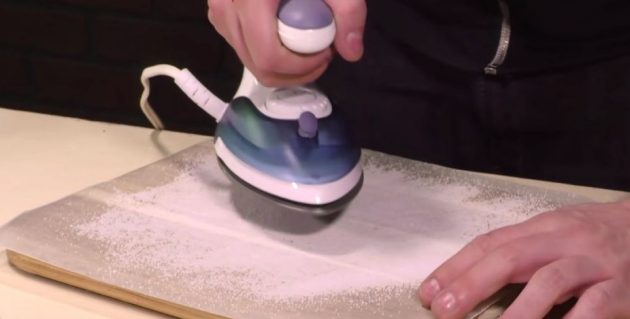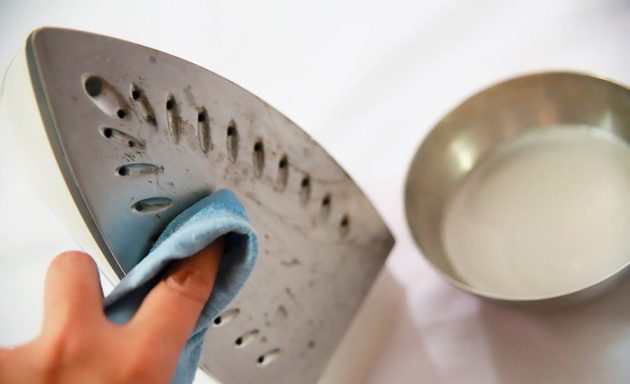After the purchase, the iron briefly pleases us with shine and cleanliness. Once you iron that silk blouse at the wrong temperature – hello, burn. Filled water from the tap – hello, scale. Here are nine ways that will help to restore the original appearance of the device.
How to clean the iron from burning
Before you start cleaning your iron, determine which method is right for your technique. Ceramic or Teflon soles, for example, cannot be rubbed with abrasives. Use the more gentle methods below.
Method 1. Salt
Sprinkle salt on a sheet of paper in an even layer and run over it with a hot iron until the blackness fades.

Method 2. Paraffin candle
Wrap the candle with a cotton cloth and rub the hot soleplate in a circular motion. Hold the iron over a tray or a layer of the newspaper; in the process, the candle will melt, the paraffin will flow down. Be careful if the work surface of your iron is embossed or has steam holes. Paraffin wax can get into the grooves and stain your clothes when you iron them later. After defeating the burn, carefully remove the remaining dirt and melted the candle.
Read also: How To Get Rid Of Refrigerator Odors
Method 3. Hydrogen peroxide
Soak a cotton swab or cloth in 3% hydrogen peroxide. Carefully and vigorously wipe dark stains off the surface of the cold iron. The peroxide will help dissolve plaque and make it easier to remove.
Method 4. Table vinegar
Soak a cotton ball in the vinegar and wipe the sole of the cold iron. If the burn is strong, add ammonia to the vinegar in a 1: 1 ratio. If that doesn’t work, soak a cloth with vinegar and cover the appliance’s work surface with it for several hours. During this time, the plaque will soften. Remove it with a sponge or soft brush.
Method 5. Baking soda
Dissolve a few tablespoons of baking soda in a glass of water, soak a piece of cloth in this solution, and wipe the iron’s cold surface with it. When finished, clean the iron from streaks with a damp sponge.

Method 6. Liquid for nail polish remover
If a piece of polyethylene sticks to the soleplate, it can be removed with nail polish remover. When cleaning, be careful not to touch the iron’s plastic parts; substances in the liquid can damage them.
Never use sandpaper, a knife or other sharp objects to clean the iron! This will scratch the soleplate and may cause the appliance to malfunction.
How to prevent burn-on
To avoid burn-in again, follow these simple tips.
- Observe the temperature regime for each type of fabric.
- Iron, especially delicate items such as wool, through wet gauze.
- Wipe the work surface of the iron with a soft cloth after each ironing.
How to descale your iron
If the steam function does not work well, and the iron leaves red spots on the clothes, it is most likely that scale has formed. Three win-win recipes will help to remove it without a trace.
Method 1. Self-cleaning function
In many modern models, the manufacturer has taken care of the problem of scale. If you are not sure about the purpose of some buttons on your unit, check the instructions; you may be the lucky owner of iron with a self-cleaning function. To do this, carefully follow the manufacturer’s advice. In short, the algorithm is.
- The maximum possible amount of water is poured into the tank.
- The temperature controller is set to maximum.
- The appliance heats up, cools down, heats up again.
- The iron is tilted over a bowl or sink.
- After pressing the self-cleaning button, limescale is removed from the steam holes on the soleplate.
After the procedure, rinse the reservoir with clean water several times and wipe the iron dry.
Method 2. Citric acid
Dissolve a tablespoon (20-30 grams) of citric acid in a glass of water and pour into the reservoir. Heat the iron to maximum, shake well several times, and press the steam release button. Carry out this procedure over a sink or container; scale will come out along with the steam in the hot dark spray. Then rinse the reservoir with clean water and wipe the soleplate of the iron from the remaining dirt.
Method 3. Sparkling mineral water
Carbonated drinks contain acids to help dissolve sediment inside the iron. Just pour the mineral water into the tank and follow the instructions from the previous point.
Also read: How To Clean The Oven: 4 Effective Remedies
How to prevent limescale formation
So that you do not have to descale in the future, control the quality of the water that you pour into the iron. For this, the best suited:
- Distilled water: available at any gas station.
- Bottled water from the nearest supermarket.
- Water purified with a home filter.
- Standing tap water: in a few hours, the salts will precipitate.
Adapted and translated by Wiki Avenue Staff
Sources: Life hacker






